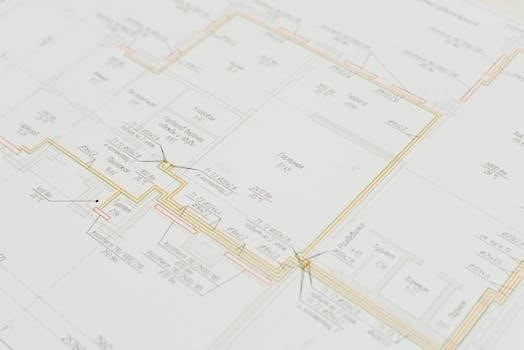
Concept maps are valuable tools for visualizing complex biological processes like cellular respiration. They help in organizing key terms and stages, providing a clear overview. These maps are useful learning aids, especially when paired with an answer key for effective review.
The Role of Concept Maps in Understanding Cellular Respiration
Concept maps serve as powerful visual aids, enhancing comprehension of cellular respiration’s intricate steps and components. They facilitate a structured approach to learning, allowing students to connect various stages, reactants, and products in a meaningful way. By visually representing the process, these maps overcome the limitations of linear text, promoting a deeper understanding of how glucose is broken down to generate ATP. The use of concept maps enables students to see the interconnectedness of glycolysis, the Krebs cycle, and the electron transport chain, highlighting their individual roles and collective contribution to cellular energy production. Moreover, this method is effective in identifying areas where understanding may be lacking, providing a targeted approach to review and revision. The interactive nature of concept mapping aids active learning, allowing for personalized organization of information. The answer keys with these concept maps provide immediate feedback, reinforcing understanding and correcting misconceptions.

Key Stages of Cellular Respiration
Cellular respiration involves several key stages⁚ glycolysis, pyruvate processing, the Krebs cycle, and the electron transport chain. Each stage plays a vital role in energy production, with specific inputs and outputs.
Glycolysis⁚ Input, Output, and Location
Glycolysis, the initial stage of cellular respiration, is a fundamental process that occurs in the cytoplasm of cells. This stage is characterized by the breakdown of a single molecule of glucose, which serves as its primary input. The process of glycolysis doesn’t require oxygen, making it a crucial step for both aerobic and anaerobic respiration. The breakdown of glucose results in the production of several key molecules. The main outputs of glycolysis are two molecules of pyruvate, a three-carbon compound, along with a net gain of two molecules of ATP, which are the primary energy currency of the cell. Furthermore, two molecules of NADH are also generated, which are crucial electron carriers for later stages of cellular respiration. Understanding these inputs, outputs and location is essential for grasping the overall process of energy production within cells. It’s a vital step in both aerobic and anaerobic pathways.
Pyruvate Processing and its Significance
Following glycolysis, pyruvate processing marks a critical transition point in cellular respiration, particularly in aerobic conditions. The two pyruvate molecules produced during glycolysis now move from the cytoplasm into the mitochondria. This process is significant as it prepares pyruvate for entry into the Krebs cycle. In this phase, each pyruvate undergoes a series of enzymatic reactions. These reactions result in the conversion of pyruvate into acetyl-CoA, a two-carbon molecule. This conversion also involves the release of carbon dioxide as a waste product and the generation of NADH. The formation of acetyl-CoA is vital, as it acts as the fuel for the Krebs cycle. Furthermore, the NADH produced during pyruvate processing contributes to the overall energy yield of cellular respiration. This stage is therefore essential for linking glycolysis to the subsequent stages of ATP production and completes the intermediate steps.
The Krebs Cycle (Citric Acid Cycle)⁚ Key Inputs and Outputs
The Krebs cycle, also known as the citric acid cycle, is a central metabolic pathway in cellular respiration. It occurs in the mitochondrial matrix. The key input for this cycle is acetyl-CoA, which is derived from pyruvate processing. This two-carbon molecule combines with a four-carbon molecule, oxaloacetate, to form citrate, kicking off the cycle. Throughout the series of reactions, the cycle regenerates oxaloacetate, allowing the process to continue. The cycle’s outputs are significant. For each acetyl-CoA molecule entering, the Krebs cycle produces two molecules of carbon dioxide, one molecule of ATP, three molecules of NADH, and one molecule of FADH2. These electron carriers, NADH and FADH2, are crucial for the final stage of cellular respiration—the electron transport chain. The cycle’s role is not only to generate these molecules but also to break down carbon compounds completely, further releasing energy.
Electron Transport Chain⁚ Function and ATP Production

The electron transport chain (ETC) is the final stage of aerobic cellular respiration, located in the inner mitochondrial membrane. Its primary function is to harness the energy stored in NADH and FADH2, produced during earlier stages. These molecules deliver high-energy electrons to a series of protein complexes within the ETC. As electrons move along the chain, they release energy, which is used to pump protons from the mitochondrial matrix to the intermembrane space, creating an electrochemical gradient. This proton gradient drives ATP synthase, an enzyme that facilitates the synthesis of ATP. Oxygen acts as the final electron acceptor, combining with protons and electrons to form water. The electron transport chain generates the majority of ATP during cellular respiration, making it a vital component for energy production in cells. Without it, the efficiency of energy extraction would be significantly reduced.

Concept Map Components and Terms
Understanding a cellular respiration concept map requires familiarity with key terms. These include glucose, pyruvate, ATP, and NADH. Also, distinguishing between aerobic and anaerobic respiration is essential for a complete understanding.
Essential Terms⁚ Glucose, Pyruvate, ATP, NADH
When exploring cellular respiration, understanding the fundamental terms is crucial. Glucose, a simple sugar (C6H12O6), serves as the primary fuel source, initiating the process. Glycolysis breaks down glucose into two molecules of pyruvate, a three-carbon compound. This breakdown yields a small amount of energy in the form of ATP (adenosine triphosphate), the cell’s primary energy currency. Another vital molecule, NADH (nicotinamide adenine dinucleotide), is a crucial electron carrier, transporting high-energy electrons needed for later stages. Together, glucose, pyruvate, ATP, and NADH form the foundational components of cellular respiration, facilitating the complex transformation of chemical energy into usable forms, as detailed in many concept map answer keys. Understanding their roles is essential for comprehending the process’s entirety. These terms are key elements that build up the process of cellular respiration.
Aerobic vs. Anaerobic Respiration
Cellular respiration is broadly categorized into aerobic and anaerobic pathways, distinguished by the presence or absence of oxygen. Aerobic respiration, which requires oxygen, is the most efficient form of energy production. It involves glycolysis, the Krebs cycle, and the electron transport chain, ultimately yielding a large amount of ATP. In contrast, anaerobic respiration occurs without oxygen. This process, which includes fermentation, produces far less ATP. Anaerobic pathways are essential for cells in environments lacking oxygen, or during periods of high energy demand. The key differences are the amount of ATP generated and the reliance on oxygen. Concept maps highlight these contrasting pathways, often using different branches to represent each process. Understanding both aerobic and anaerobic respiration is crucial for comprehending how cells generate energy under diverse conditions. This distinction is also often emphasized in answer keys.

Using Concept Maps for Learning
Concept maps are powerful tools in learning cellular respiration, offering visual representations of complex steps. They enhance understanding and improve retention, and answer keys help to check accuracy and reinforce learning;
How Concept Maps Aid in Visualizing the Process
Concept maps significantly aid in visualizing the intricate process of cellular respiration by presenting a structured overview of its various stages and components. Unlike linear notes, concept maps allow for a non-sequential exploration, highlighting relationships between key terms like glucose, pyruvate, ATP, and NADH. The visual layout helps learners grasp the flow of energy and matter through glycolysis, the Krebs cycle, and the electron transport chain. By clearly connecting inputs, outputs, and locations, these maps facilitate a deeper understanding of how each stage contributes to the overall production of ATP. This visual approach simplifies complex pathways and makes it easier to see the big picture of cellular respiration. Moreover, the use of arrows and connecting lines makes it easier to follow the flow of the process, transforming abstract concepts into a tangible and comprehensible format, thus making the learning experience more effective and engaging.
Concept Map Answer Keys⁚ Checking Understanding
Answer keys for cellular respiration concept maps are essential tools for students to check their understanding and identify areas needing further study. These keys provide a structured reference, confirming the correct connections between different stages and terms like glycolysis, the Krebs cycle, and the electron transport chain. By comparing their completed maps with the answer key, students can assess their comprehension of key inputs and outputs, as well as locations within the cell. The answer key acts as a form of immediate feedback, enabling self-correction and reinforcing accurate understanding of the complex process. This allows learners to not only verify their knowledge but also refine their understanding by identifying any misconceptions or gaps. Moreover, the answer key facilitates a deeper analysis of the interconnectedness of cellular respiration, supporting effective and independent learning. This promotes critical thinking skills and enhances long-term retention of the material.